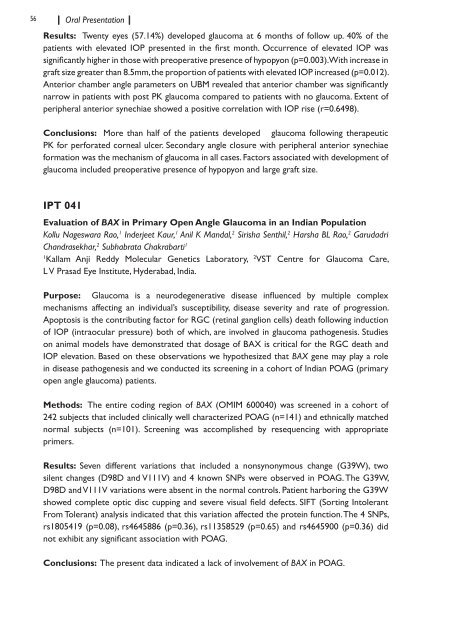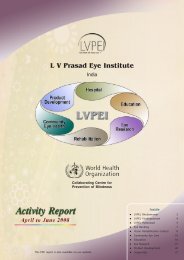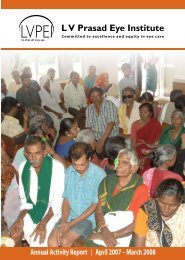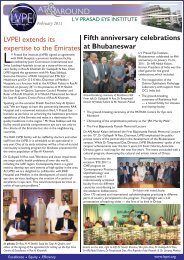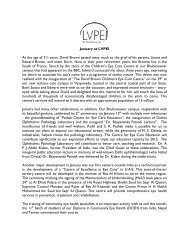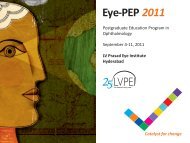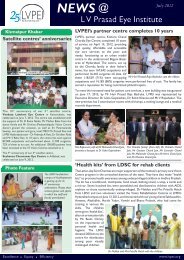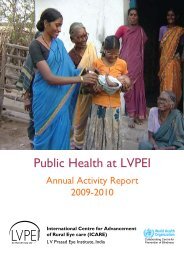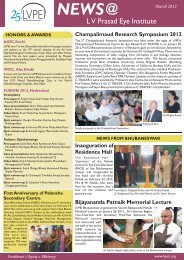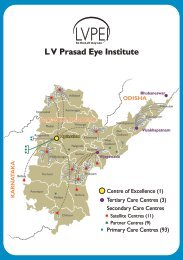IERG Abstracrt Book.indd - LV Prasad Eye Institute
IERG Abstracrt Book.indd - LV Prasad Eye Institute
IERG Abstracrt Book.indd - LV Prasad Eye Institute
Create successful ePaper yourself
Turn your PDF publications into a flip-book with our unique Google optimized e-Paper software.
56 Oral PresentationResults: Twenty eyes (57.14%) developed glaucoma at 6 months of follow up. 40% of thepatients with elevated IOP presented in the first month. Occurrence of elevated IOP wassignificantly higher in those with preoperative presence of hypopyon (p=0.003). With increase ingraft size greater than 8.5mm, the proportion of patients with elevated IOP increased (p=0.012).Anterior chamber angle parameters on UBM revealed that anterior chamber was significantlynarrow in patients with post PK glaucoma compared to patients with no glaucoma. Extent ofperipheral anterior synechiae showed a positive correlation with IOP rise (r=0.6498).Conclusions: More than half of the patients developed glaucoma following therapeuticPK for perforated corneal ulcer. Secondary angle closure with peripheral anterior synechiaeformation was the mechanism of glaucoma in all cases. Factors associated with development ofglaucoma included preoperative presence of hypopyon and large graft size.IPT 041Evaluation of BAX in Primary Open Angle Glaucoma in an Indian PopulationKollu Nageswara Rao, 1 Inderjeet Kaur, 1 Anil K Mandal, 2 Sirisha Senthil, 2 Harsha BL Rao, 2 GarudadriChandrasekhar, 2 Subhabrata Chakrabarti 11Kallam Anji Reddy Molecular Genetics Laboratory, 2 VST Centre for Glaucoma Care,L V <strong>Prasad</strong> <strong>Eye</strong> <strong>Institute</strong>, Hyderabad, India.Purpose: Glaucoma is a neurodegenerative disease influenced by multiple complexmechanisms affecting an individual’s susceptibility, disease severity and rate of progression.Apoptosis is the contributing factor for RGC (retinal ganglion cells) death following inductionof IOP (intraocular pressure) both of which, are involved in glaucoma pathogenesis. Studieson animal models have demonstrated that dosage of BAX is critical for the RGC death andIOP elevation. Based on these observations we hypothesized that BAX gene may play a rolein disease pathogenesis and we conducted its screening in a cohort of Indian POAG (primaryopen angle glaucoma) patients.Methods: The entire coding region of BAX (OMIM 600040) was screened in a cohort of242 subjects that included clinically well characterized POAG (n=141) and ethnically matchednormal subjects (n=101). Screening was accomplished by resequencing with appropriateprimers.Results: Seven different variations that included a nonsynonymous change (G39W), twosilent changes (D98D and V111V) and 4 known SNPs were observed in POAG. The G39W,D98D and V111V variations were absent in the normal controls. Patient harboring the G39Wshowed complete optic disc cupping and severe visual field defects. SIFT (Sorting IntolerantFrom Tolerant) analysis indicated that this variation affected the protein function. The 4 SNPs,rs1805419 (p=0.08), rs4645886 (p=0.36), rs11358529 (p=0.65) and rs4645900 (p=0.36) didnot exhibit any significant association with POAG.Conclusions: The present data indicated a lack of involvement of BAX in POAG.


